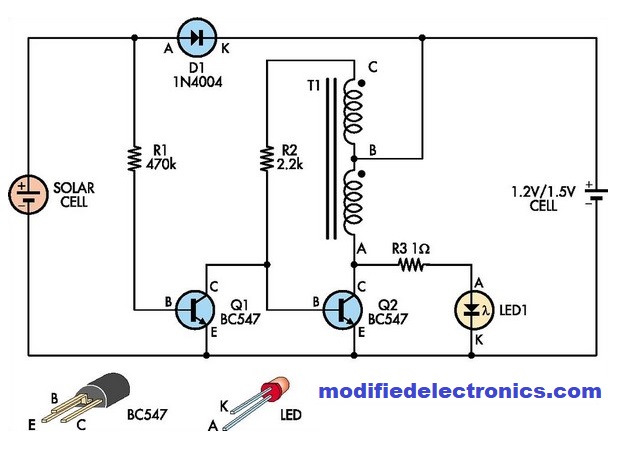Introduction
In this blog post, we will explore the construction and working of an Automatic White-LED Garden Light using BC547 transistor. This circuit is designed to turn on the LED automatically at night and is powered by a single 1.2V nicad cell, which is recharged by a solar cell during the day. Whether you’re a DIY enthusiast or simply looking for an eco-friendly lighting solution for your garden, this project is worth considering.
Components Required
To build this automatic garden light circuit, you will need the following components:
Hardware Required
| 2 | × | BC547 transistor |
| 1 | x | LED (white LED) |
| 1 | × | 1N4004 Diode |
| 1 | x | Solar cell |
| 3 | × | Resistor (1Ω, 2.2K, 470K) |
| 1 | × | Transformer |
| 1 | × | 1.2v to 1.5v nicad cell |
Circuit Diagram

Define the Circuit
The circuit consists of several key components that work together to provide automatic lighting in your garden. Let’s understand how each component functions:
1. Solar Cell and Diode D1: The solar cell charges the nicad cell during the day. Diode D1 prevents the battery from discharging back into the solar cell at night.
2. Transistor Q1: During the day, when there is output from the solar cell, Q1 is on, keeping Q2 and the LED off.
3. Oscillator Circuit: At night, when Q1 turns off, a blocking oscillator circuit based on T1, R2, and Q2 comes into play. This circuit drives LED1 via a 1W resistor, which limits the peak current into the LED.
4. Transformer T1: T1 is wound bifilar, with winding AB as the main primary winding and winding BC as the feedback winding. The number of turns and the core used are not critical. The core produces a magnetic flux when Q2 is turned on, causing end C to rise above the battery voltage and turn Q2 on hard.
How It Works
Here’s how the circuit operates:
1. When Q1 turns off, current flows through R2 and turns Q2 on. This causes current to flow through winding AB, generating a magnetic flux in the core.
2. As the core saturates, the voltage at end C drops back to the battery voltage, reducing the current in winding AB. The falling flux in the core causes the voltage at C to drop below 0.6V, turning off Q2.
3. With no current in winding AB, the flux in the core collapses, causing the voltage on end A to rise above the battery voltage. When it reaches 3.2-3.6V with respect to ground, LED1 “fires” and current flows through the LED.
4. Once the flux is spent, LED1 turns off, and end C returns to the battery voltage. The cycle repeats when the voltage on end A rises again.
5. When the sun rises, Q1 turns on, stopping the oscillation and turning off LED1.
Applications
The automatic white-LED garden light using the BC547 transistor has various applications, including:
- Illuminating garden pathways or features
- Providing ambient lighting for outdoor gatherings
- Serving as a security light to deter intruders
- Enhancing the aesthetics of your garden
With its simple design and energy-efficient operation, this garden light is a great addition to any outdoor space.
So, why not try building your own automatic white-LED garden light? It’s a fun and rewarding project that combines technology and nature, while providing practical illumination when needed.